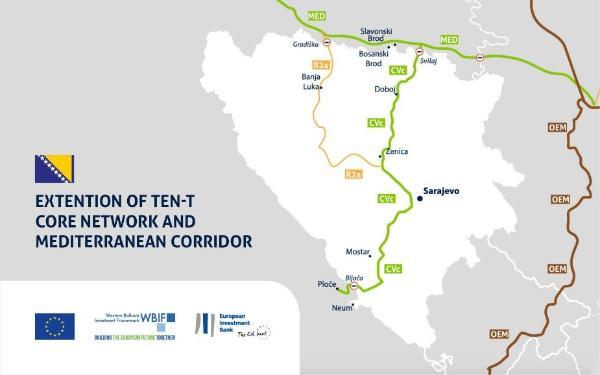Long lines of vehicles and frustrated drivers are a common site at the Gradiška border crossing between Bosnia and Herzegovina and Croatia. The situation is especially difficult for truckers, who frequently have to wait for up to eight hours, resulting in delays in delivering goods and commodities that severely impede economic growth.
Together with €3.15 million grant from the European Union, the European Investment Bank is financing construction of a new border crossing and bridge in Gradiška with a loan of €65 million, including the construction of a section of motorway between Banja Luka and Gradiška which was finished in 2011. Once the new border crossing is finished, it will provide a connection to the Trans-European Core Network on Corridor Vc and become a game-changer for the local economy. The 430-metre bridge over the River Sava will link the two countries and slash waiting times at the border on Route 2a, which runs 239 km from Lasva (Zenica) via Banja Luka in Bosnia and Herzegovina to Okučani in Croatia. It is expected to be completed by spring 2022.
“We wait at the border for five, six, seven sometimes even eight hours,” says truck driver Teran Mušinovič, who frequently commutes along this route. “I think that, when a new crossing is finished, the vehicle lines will be shorter and transit to European countries faster.”
Bosnia-Croatia border crossing is a faster and easier route to EU
Currently, the route runs through the urban area of Gradiška for approximately 2 km, causing traffic congestion, bottlenecks and air pollution. As part of the Corridor Vc investment project, the cross-border facilities have been built about 3 km to the west of the existing facilities and outside the urban area.
There are other benefits to the local economy and to people from both countries.
“This highway link to Europe means faster and easier arrival in Croatia,” says Marko Lovrić, an engineer on the Gradiška Bridge. “The exchange of goods and people will significantly increase, especially because the former border crossing was located in the city centre, causing large traffic jams and slow entrance into Bosnia and Herzegovina and Croatia alike.
“Building a new road all the way up to the border crossing and linking it directly to the highway will accelerate the flow of goods and people. In that way, communication will improve, as well as relations.”

A new road stretches along R2a route and connects to Corridor Vc, which is the pivotal transit road in the region running through Bosnia and Herzegovina. Over 95% of goods and passengers runs through this network, while more than 50% of the population lives in the area around the route. It starts in Budapest, crossing 325 kilometres through Bosnia and Herzegovina via Doboj, Zenica, Sarajevo and Mostar, to end in the Croatian port of Ploče.
It has been identified as “Flagship 2, Connecting North to South” in the European Commission’s Economic and Investment Plan for the Western Balkans.
“With 105 km already built in the Republika Srpska and 200 km of the new motorway in Bosnia and Herzegovina, we will have the most advanced motorway network with the highest safety standards for all users on the roads,” says Davor Vučković, coordinator at the public enterprise JP Autoputevi, the motorway company in Republika Srpska in charge of the project implementation.
The European Union provides continuous support for the construction of Corridor Vc, channelling grants through the European Western Balkans Joint Fund under the Western Balkans Investment Framework (WBIF). The entire project combines efforts of the local authorities, the European Union, the European Investment Bank and the European Bank for Reconstruction and Development.
Jobs created for 7 000 people
The European Union support for this national programme brings employment for young engineers on Corridor Vc. Total jobs on the project are as high as 7 000.
“This is my first job after finishing school and for me, this is a great opportunity and foundation for my future development and professional experience in the field of tunnel construction,” says Amel Mujagić, an engineer on Tunnel Ivan, located on Tarčin-Ivan subsection of Corridor Vc.
To date, the European Investment Bank invested close to €1 billion in this ambitious transit route, while the European Union invested over €200 million in grants under the Connectivity Agenda.
“We are glad to see this kind of initiative that create new business and job opportunities,” says Lilyana Pavlova, vice president at the European Investment Bank. “Every kilometer of a new modern motorway shortens the distance between places and people and creates new economic and personal ties between countries in the Western Balkans and the European Union alike.”
“Being able to travel and transport goods faster and more safely, to commute more comfortably,” adds Pavlova, “is one the legacies of modern Europe and these standards need to be available to everybody.”
